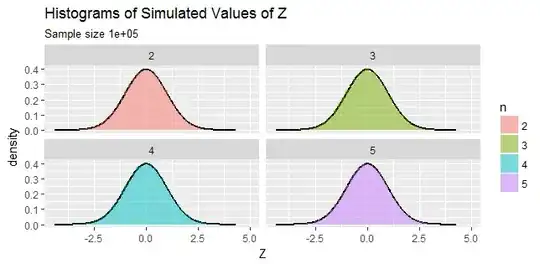$X$ and $Y$ are independently distributed random variables where $X\sim\chi^2_{(n-1)}$ and $Y\sim\text{Beta}\left(\frac{n}{2}-1,\frac{n}{2}-1\right)$. What is the distribution of $Z=(2Y-1)\sqrt X$ ?
Joint density of $(X,Y)$ is given by
$$f_{X,Y}(x,y)=f_X(x)f_Y(y)=\frac{e^{-\frac{x}{2}}x^{\frac{n-1}{2}-1}}{2^{\frac{n-1}{2}}\Gamma\left(\frac{n-1}{2}\right)}\cdot\frac{y^{\frac{n}{2}-2}(1-y)^{\frac{n}{2}-2}}{B\left(\frac{n}{2}-1,\frac{n}{2}-1\right)}\mathbf1_{\{x>0\,,\,0<y<1\}}$$
Using the change of variables $(X,Y)\mapsto(Z,W)$ such that $Z=(2Y-1)\sqrt X$ and $W=\sqrt X$,
I get the joint density of $(Z,W)$ as
$$f_{Z,W}(z,w)=\frac{e^{-\frac{w^2}{2}}w^{n-3}\left(\frac{1}{4}-\frac{z^2}{4w^2}\right)^{\frac{n}{2}-2}}{2^{\frac{n-1}{2}}\Gamma\left(\frac{n-1}{2}\right)B\left(\frac{n}{2}-1,\frac{n}{2}-1\right)}\mathbf1_{\{w>0\,,\,|z|<w\}}$$
Marginal pdf of $Z$ is then $f_Z(z)=\displaystyle\int_{|z|}^\infty f_{Z,W}(z,w)\,\mathrm{d}w$, which does not lead me anywhere.
Again, while finding the distribution function of $Z$, an incomplete beta/gamma function shows up:
$F_Z(z)=\Pr(Z\le z)$
$\quad\qquad=\Pr((2Y-1)\sqrt X\le z)=\displaystyle\iint_{(2y-1)\sqrt{x}\le z}f_{X,Y}(x,y)\,\mathrm{d}x\,\mathrm{d}y$
What is an appropriate change of variables here? Is there another way to find the distribution of $Z$?
I tried using different relations between Chi-Squared, Beta, 'F' and 't' distributions but nothing seems to work. Perhaps I am missing something obvious.
As mentioned by @Francis, this transformation is a generalization of the Box-Müller transform.
